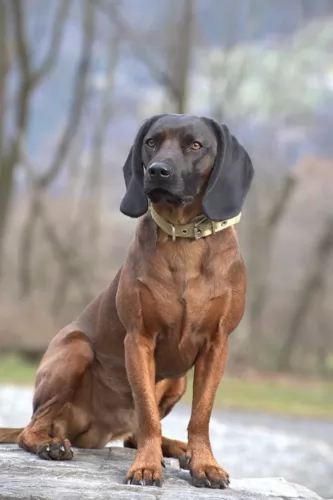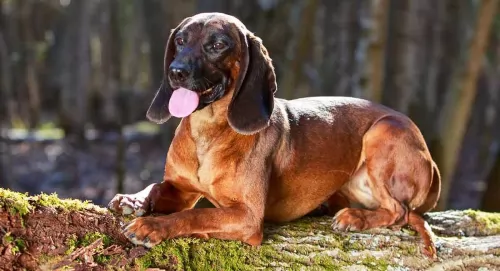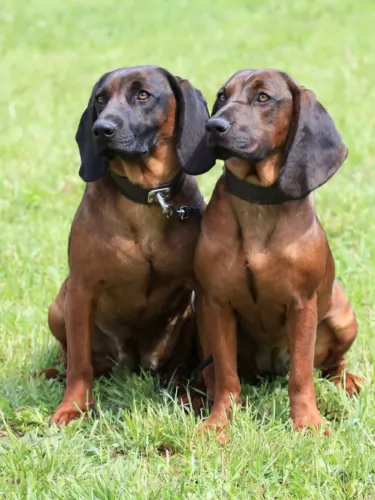 Petzlover
Petzlover Bavarian Mountain Hound is originated from Germany but Scottish Deerhound is originated from United Kingdom. Bavarian Mountain Hound may grow 29 cm / 11 inches shorter than Scottish Deerhound. Bavarian Mountain Hound may weigh 25 kg / 55 pounds lesser than Scottish Deerhound. Bavarian Mountain Hound may live 5 years more than Scottish Deerhound. Bavarian Mountain Hound may have less litter size than Scottish Deerhound. Bavarian Mountain Hound requires Moderate Maintenance. But Scottish Deerhound requires Low Maintenance
Bavarian Mountain Hound is originated from Germany but Scottish Deerhound is originated from United Kingdom. Bavarian Mountain Hound may grow 29 cm / 11 inches shorter than Scottish Deerhound. Bavarian Mountain Hound may weigh 25 kg / 55 pounds lesser than Scottish Deerhound. Bavarian Mountain Hound may live 5 years more than Scottish Deerhound. Bavarian Mountain Hound may have less litter size than Scottish Deerhound. Bavarian Mountain Hound requires Moderate Maintenance. But Scottish Deerhound requires Low Maintenance
 The Bavarian Mountain Hound was originally bred mixing the Bavarian Hound and the Hanover Hound. They decided to mix these breeds in a hope that the new breed will have the best of the parents. Actually, it turned out better than they could even imagine, since they created a great family dog, with magnificent stamina, quiet temperament and supersensitive nose that made them great hunters.
The Bavarian Mountain Hound was originally bred mixing the Bavarian Hound and the Hanover Hound. They decided to mix these breeds in a hope that the new breed will have the best of the parents. Actually, it turned out better than they could even imagine, since they created a great family dog, with magnificent stamina, quiet temperament and supersensitive nose that made them great hunters.
 The Scottish Deerhound is considered the Royal Dog of Scotland. It is a sighthound that is large and bred to hunt large Red Deer. They are similar in appearance to the Greyhound, but they are bigger and heavier. Closely related to the Irish Wolfhound, they were used in creating it. The Scottish Deerhound is an ancient breed that is now very rare. It can trace its lineage to the 16th and 17th centuries.
The Scottish Deerhound is considered the Royal Dog of Scotland. It is a sighthound that is large and bred to hunt large Red Deer. They are similar in appearance to the Greyhound, but they are bigger and heavier. Closely related to the Irish Wolfhound, they were used in creating it. The Scottish Deerhound is an ancient breed that is now very rare. It can trace its lineage to the 16th and 17th centuries.
The Deerhound was a favorite of hunting nobility and could not be kept by any person or household that did not have at least the rank of earl. Despite this history the Scottish Deerhound was not considered separate from the Highland Greyhound and other staghounds until the 19th century. They were bred to stalk or “course” the red deer and were used extensively for this purpose until the beginning of the 20th century. At that time there was a need for smaller, slower deer tracking dogs.
At the start of the 20th century, the land for deer hunting had grown smaller and so had the deer. Also, the invention of the rifle made the fast Deerhounds who could cover large tracks of ground in minutes, no longer a necessity for successful hunting. As the clan systems fell and the nobility rose, the Deerhounds became the dog for nobility and landowners. There were a few non-nobilities who also kept them and hunted with them. As they were less needed for hunting a few households kept them as show dogs.
In the United States and Canada, both the Scottish Deerhound and the Greyhound were used for hunting wolves and deer. In Australia, the Kangaroo Dog – a deerhound crossbreed, and Deerhounds were used to hunt wild boar, emu and kangaroos. The Deerhound is one of the oldest of the breeds that are Greyhound-like. The Deerhound is not as fast as the Greyhound if they are running on a smooth surface. Get them on a rough surface and the will out that Greyhound. They appear to be larger and rougher than they really are. This gives them an advantage over the lighter, smaller Greyhound.
The Deerhound was a contributor to development of the Irish Wolfhound toward the end of the 19th century.
 The Bavarian Mountain Hound is a medium sized breed of a dog. They have larger bones, but there is a very low risk of obesity. This is a very active dog, with a very muscular body. Their bone structure defines in a wide chest, and their back legs set a little bit higher than the front legs. They have strong necks and pear-shaped heads. They have strong jaws, ideal for a hunting dog. They are very specific because of their big brown eyes. The Bavarian Mountain Hound is a perfect pet. First of all, he is not a pack dog. He gets attached to his family and he is not very friendly with strangers. If they are trained well, they will never attack a stranger but they will bark and let you know that something isn’t right.
The Bavarian Mountain Hound is a medium sized breed of a dog. They have larger bones, but there is a very low risk of obesity. This is a very active dog, with a very muscular body. Their bone structure defines in a wide chest, and their back legs set a little bit higher than the front legs. They have strong necks and pear-shaped heads. They have strong jaws, ideal for a hunting dog. They are very specific because of their big brown eyes. The Bavarian Mountain Hound is a perfect pet. First of all, he is not a pack dog. He gets attached to his family and he is not very friendly with strangers. If they are trained well, they will never attack a stranger but they will bark and let you know that something isn’t right.
 The Scottish Deerhound looks a lot like the Greyhound, except it is heavily boned and larger in size. The Deerhound is also different in several other ways. Instead of the Greyhound, the Scottish Deerhound is more closely related to the Irish Wolfhound than the Deerhound. The Deerhound is a large, rough coated breed. It is a very tall breed; in fact, it is the tallest of all sighthounds.
The Scottish Deerhound looks a lot like the Greyhound, except it is heavily boned and larger in size. The Deerhound is also different in several other ways. Instead of the Greyhound, the Scottish Deerhound is more closely related to the Irish Wolfhound than the Deerhound. The Deerhound is a large, rough coated breed. It is a very tall breed; in fact, it is the tallest of all sighthounds.
The Deerhound has a long head with a flat skull and a muzzle that tapers at the end. They have dark eyes and a scissor bite with a tail that can be either curved or straight. The hair on their tails almost touches the ground. The rest of its coat is wiry and harsh with a beard, mustache and mane. The ears are soft and can be either held semi erect or folded against their head. Their coat is gray or grey-blue today but in the past, it might have been brindle, red fawn or yellow.
 Special talents: Since the Bavarian Mountain Hound is born with a strong scent, they are great for hunting. They can be trained to be search dogs.
Special talents: Since the Bavarian Mountain Hound is born with a strong scent, they are great for hunting. They can be trained to be search dogs.
If you live slow and quiet life indoors, maybe the Bavarian Mountain Hound is not the best choice for you. They are a calm breed, they do not bark a lot, but they need daily outdoor activity. They usually get attached to the owner, but in case you raise this dog in a family, they will be attached to adults and the children. They are very good while playing and living with the children, but if you usually have a lot of other children or strangers in a house, he will adapt to that kind of social life very easy.
It is very important that you start an early socialization of your Bavarian Mountain Hound. In situations where you raise this breed without the social life, they will have difficulties when they find themselves in situations with other animals. If you raise this breed with other animals in the same home, they will learn to play with other dogs, cats etc.
Bavarian Mountain Hound is not easy to train because they get easy distracted with smelling something more interesting than listening to your commands. It is not advised to have this breed as your first pet because they need an experienced trainer with a lot of patience and understanding.
 The Bavarian Mountain Hound is a quiet type of the dog. They don’t ask for a lot of attention and even if they develop some health issues you will have a hard time finding it out. So, the regular vet checks are a necessity. They usually suffer from an ear infection. The vet will usually check for a hip or an elbow dysplasia since those diseases occur with highly active breeds. Some irritations with eyelids are also found in the medical history of this breed but they are generally very rare.
The Bavarian Mountain Hound is a quiet type of the dog. They don’t ask for a lot of attention and even if they develop some health issues you will have a hard time finding it out. So, the regular vet checks are a necessity. They usually suffer from an ear infection. The vet will usually check for a hip or an elbow dysplasia since those diseases occur with highly active breeds. Some irritations with eyelids are also found in the medical history of this breed but they are generally very rare.
 The Scottish Deerhound does face some serious challenges on the health front. These include:
The Scottish Deerhound does face some serious challenges on the health front. These include:
• Cystinuria – recessive disorder that causes an inability for cystine to be filtered from the urine.
• Gastric Dilatation Volvulus – otherwise known as bloat and it can be life threatening if not treated quickly.
 There is a big difference in feeding the Bavarian Mountain Hound since you can raise him to be a pet or a dog for hunting. If you decided to keep this breed as a pet, they will do just fine with one of the dry foods that are good quality. If you want to raise them as a hunting dog, an active dog, then they will need a high-quality dry food and occasionally some raw minced meat.
There is a big difference in feeding the Bavarian Mountain Hound since you can raise him to be a pet or a dog for hunting. If you decided to keep this breed as a pet, they will do just fine with one of the dry foods that are good quality. If you want to raise them as a hunting dog, an active dog, then they will need a high-quality dry food and occasionally some raw minced meat.
High-quality food for puppies with a lot of nutrients that will help in growing the healthy bones and beautiful coat.
Since they have a short coat, the Bavarian Mountain Hounds don’t need a regular or any special kind of grooming. They will do just fine with occasional brushing. They don’t shed a lot, but in a season when they do you are free to brush them more regularly. They enjoy the brushings, cuddles, scratching, belly rubs - they are very lovable breed. But, as advised, take them to regular vet check because they can be very quiet even when they feel the pain.
The Bavarian Mountain Hound has a gene of a working dog and that is the reason why they need a lot of the activity on a daily basis. No matter if you take him to walk, run or a bike ride, they will love it. They do not like being on the leash since they love to use their nose to play. If you socialise them well, the dog park will be a great thing for them.
 1.Feeding the puppy – Feed a high quality large or x large puppy dogfood at least 3-4 times a day. Do not overfeed.
1.Feeding the puppy – Feed a high quality large or x large puppy dogfood at least 3-4 times a day. Do not overfeed.
2.Feeding the adult – Feed a high-quality adult large or x large dog food once or twice a day. Do not overfeed.
4. Games and Exercises – The Deerhound needs plenty of exercise in a safe place where they have plenty of room to run. A small yard or life on a leash are not enough for this energetic breed. Play fetch, course running, Like the Greyhound they will be couch potatoes if you let them but that will hurt their health. Lure Coursing or hare coursing are good. Coyote hunting. Find space where they can run for the joy of running. Never force them to run – like along a bicycle